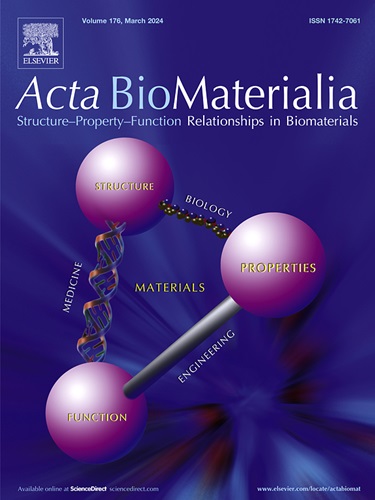Rho kinase inhibitor Y-27632 and dual media culture approach promote the construction and transplantation of rabbit limbal epithelial cell sheets via cell spheroid culture and auto-bioprinting
IF 9.4
1区 医学
Q1 ENGINEERING, BIOMEDICAL
引用次数: 0
Abstract
The shortage of corneal donors and the limitations in tissue engineering grafts, such as biocompatibility and mechanical properties, pose significant challenges in corneal transplantation. Here, for the first time, we investigate the effect of Rho kinase inhibitor Y-27632 and a dual media culture approach, including proliferative media (M1) and stabilizing media (M2), on rabbit limbal epithelial stem cells (LESCs), aiming to explore the feasibility of constructing corneal cell sheets in vitro through auto-bioprinting and assessing their corneal wound healing capacity in vivo. Y-27632 has primarily demonstrated significantly enhanced LESCs growth, proliferation, and reduced apoptosis. The dual media culture approach combined with Y-27632 improved LESCs proliferation while maintaining stemness. In spheroid culture, Y-27632 decreased cell death and promoted proliferation. Immunofluorescent staining and RNA sequencing revealed upregulation of genes related to tight junctions and cell adhesion and downregulation of genes associated with aging and cell cycle. Using a bioprinter, LESC spheroids were auto-bioprinted onto a custom-made curved collagen membrane, creating a bioactive, transplantable, tissue-engineered anterior corneal sheet. Anterior superficial corneal transplantation with these LESC sheets significantly accelerated epithelial wound healing in rabbit limbal stem cell deficiency (LSCD) models. Overall, the integration of Y-27632, dual-media culture, and spheroid cell culture led to the development of a highly bioactive and therapeutically promising bio-ink derived from LESCs. Auto-bioprinting these LESC spheroids produced a bioactive, transplantable corneal cell sheet, presenting a promising therapeutic option for LSCD.
Statement of Significance
The renewal and wound healing of the corneal epithelium are essential for maintaining normal vision and refractive function. Limbal stem cell deficiency (LSCD) is a major cause of blinding keratopathy, and current treatment options are limited. In this study, for the first time, we developed a highly bioactive and therapeutically potent bio-ink for ocular surface regeneration by integrating Y-27632, a dual-media culture approach, and spheroid cell culture. Additionally, using auto-bioprinting technology, the limbal epithelial stem cell (LESC) spheroid bio-ink was precisely auto-bioprinted onto the curved surface of the corneal membrane, significantly accelerating corneal epithelial healing in an LSCD rabbit model.

Y-27632 和双培养基培养法通过细胞球状培养和自动生物打印促进了兔眼睑上皮细胞片的构建和移植。
角膜供体的短缺和组织工程移植在生物相容性和力学性能等方面的局限性,给角膜移植带来了重大挑战。在此,我们首次研究了Rho激酶抑制剂Y-27632和增殖培养基(M1)和稳定培养基(M2)双培养基培养方法对兔角膜缘上皮干细胞(LESCs)的影响,旨在探索通过生物自动打印体外构建角膜细胞片的可行性,并评估其角膜创面愈合能力。Y-27632主要表现为显著增强LESCs生长、增殖和减少凋亡。双介质培养方法与Y-27632结合,在保持细胞干性的同时,提高了LESCs的增殖能力。在球形培养中,Y-27632减少细胞死亡,促进细胞增殖。免疫荧光染色和RNA测序显示,与紧密连接和细胞粘附相关的基因上调,与衰老和细胞周期相关的基因下调。使用生物打印机,LESC球体被自动生物打印到定制的弯曲胶原蛋白膜上,创造出具有生物活性、可移植的组织工程角膜前片。在兔角膜缘干细胞缺乏症(LSCD)模型中,使用这些LESC片进行前浅表角膜移植可显著加速上皮伤口愈合。总的来说,Y-27632、双培养基培养和球形细胞培养的整合导致了LESCs衍生的高生物活性和治疗前景的生物墨水的发展。自动生物打印这些LESC球体产生了具有生物活性的可移植角膜细胞片,为LSCD提供了一个有希望的治疗选择。意义声明:角膜上皮的更新和伤口愈合是维持正常视力和屈光功能所必需的。角膜缘干细胞缺乏症(LSCD)是致盲性角膜病变的主要原因,目前的治疗方案有限。在这项研究中,我们首次将Y-27632、双培养基培养方法和球形细胞培养相结合,开发了一种具有高度生物活性和治疗效果的眼表再生生物墨水。此外,利用自动生物打印技术,将角膜缘上皮干细胞(LESC)球形生物墨水精确地自动生物打印到角膜膜的曲面上,显著加速了LSCD兔模型角膜上皮的愈合。
本文章由计算机程序翻译,如有差异,请以英文原文为准。
求助全文
约1分钟内获得全文
求助全文
来源期刊

Acta Biomaterialia
工程技术-材料科学:生物材料
CiteScore
16.80
自引率
3.10%
发文量
776
审稿时长
30 days
期刊介绍:
Acta Biomaterialia is a monthly peer-reviewed scientific journal published by Elsevier. The journal was established in January 2005. The editor-in-chief is W.R. Wagner (University of Pittsburgh). The journal covers research in biomaterials science, including the interrelationship of biomaterial structure and function from macroscale to nanoscale. Topical coverage includes biomedical and biocompatible materials.
 求助内容:
求助内容: 应助结果提醒方式:
应助结果提醒方式:


